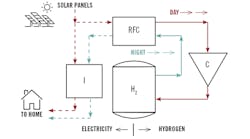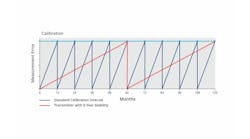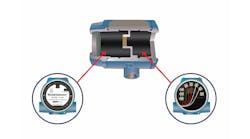The temperature of Earth remains constant if it receives the same amount of heat as it radiates back into space. If the amount received exceeds that leaving, global warming (GW) occurs. To stop this rise, either the heat added by the greenhouse effect must be reduced, or some sort of “cooling valve” must be opened so that, for example, more heat can be radiated to space.
Cooling can be increased by making the human footprint whiter through more reflective roofs, roads and agriculture. Today, the opposite is occurring; global reflectivity is dropping as highly reflective snow melts and is replaced by heat absorbing water and land. In fact, reflectivity of Earth (the controlled process) is self-accelerating in the wrong direction: melting increases GW and GW further increases melting.
The only component of global heat-balance that is widely appreciated is the need to reduce the greenhouse effect, yet emissions of the gases that contribute to it continue to rise.
The UN, EU and the U.S. are all contemplating emissions reduction to “net carbon zero” or "net carbon neutral” by 2050—and getting halfway there by 2030. But this cooling control valve has not even been built and is already undersized. Why? Because net zero emission means that we reduce our emissions to the point that we put only as much carbon into the air as is taken out by the oceans and vegetation. In other words, net zero is not zero emissions, but only a state when the quantity of the carbon in the atmosphere is no longer rising
If the accumulated carbon in the air stays there, the heat input remains higher than the heat losses and GW continues to increase. In addition, this does nothing about the tipping points which will be triggered by wildfires, ocean degassing, permafrost melting and increased concentration of water vapor in the air, which will all combine their accelerating feedbacks into a rising of GW. I calculated in my forthcoming book, Controlling the Future, that this effect will start before 2030 and will be larger than the planned cut to "net" zero emissions.
Selecting the coolant
The coolant in this undersized cooling valve is human behavior. In the past, the tools of education, science, cultural and ethical arguments have all been tried, but none of them worked. None had enough influence to change human behavior. Now Mother Nature is beginning to tell us “stop or else!" and our primary response is just to treat the symptoms. We build dams, move people out of flood-prone or drought-stricken areas, reroute roads and water pipes, bury electric grid cables and the like.
On top of that, climate-change deniers argue that neither the 1.2 °C rise we’ve experienced thus far—nor the Paris agreement limit of 2.0 °C—are much to worry about, and that the weather changed in the past anyway. Well, NASA tells us the global temperature anomaly during the past half million years never exceeded +2 °C, and when it dropped to -3.0 °C, North America was covered with a mile-thick layer of ice.
So, coming back to human nature, we know that man responds to financial interest and therefore the coolant flowing through our cooling valve must be money. Consequently, fossil fuel subsidies must be eliminated and carbon plus methane taxes introduced. The taxing of methane is important because natural gas is almost all methane, and its greenhouse effect is a hundred times greater than that of carbon dioxide. Cross-border import taxes should be introduced, and industries should be allowed to sell their carbon emission savings to companies that exceed the permitted limits. All these taxes should go into a dedicated fund that can only be used for supporting the conversion to green energy and to finance the reeducation of people whose fossil fuel jobs have been eliminated, but who are needed to fill the millions of new jobs created by this immense transformation.
Learning from nature
In the past, balance existed because plants used solar energy to split water from the ground into hydrogen and oxygen, then combine that hydrogen with carbon dioxide from the air to produce food energy for people. Over the past century, plant life diminished and our global energy consumption increased over 30-fold (population increased seven-fold and energy consumption per capita five-fold). We can regain balance by planting "artificial trees." That is, using solar energy to split water and using the generated hydrogen as our free and inexhaustible energy source. We already have the technology to do this. All it takes is mass production to get the cost of the "green" hydrogen down below that of the "grey" hydrogen made from hydrocarbons.
The technology to split water by using solar energy is growing in both efficiency and capacity. As of 2021, the capacity of the largest units are 10 MW polymer electrolyte membrane (PEM) systems. Meanwhile, the efficiency of electrolyzers has increased from 64% to 82% in recent years. Once the hydrogen is generated, it is compressed to about 350 bar (5,000 psig) for storage and transportation. Compression requires about 1.05 kWh/kg energy and when used in electric cars, the fuel cell efficiencies range from 40% to 80% while the thermal efficiency of internal combustion engines is about 20%.
Compared to conventional electric vehicles (EV), hydrogen cars are better because they don't waste mileage by dragging around 1,200 pounds of batteries; they take only minutes to refill; don't necessarily cause carbon emissions (because hydrogen can be generated from solar energy); don't need lithium that soon will be in short supply; and they don't catch fire due to excessive energy density in their batteries.
In locations where there is no electric grid or where the supply is unreliable, homes and electric cars can also be fueled by hydrogen teamed with solar panels and reversible fuel cells (RFCs). These devices store the excess solar energy in the form of hydrogen during the day and at night (or on cloudy days) use that hydrogen to provide electricity for the home. The storage tank is the same as used in a hydrogen-fueled car and is serviced the same way as propane tanks are today (Figure 1). Once installed, the electricity generated is free.
In private homes, hydrogen can also eliminate the need for diesel generators because it can meet the electricity needs of an average home for more than 10 days. Also, during peak periods of electricity demand, the stored hydrogen and the electricity in the car batteries can supplement the electricity available from the grid.
To sum up, the tipping points are about to be reached (dead time over) and staying under 1.5 °C warming is no longer possible. July was the hottest month in recorded history and greenhouse gas concentrations have not been this high in 2 million years. We are well on our way to having 1 billion people exposed to life-threatening heat waves, water shortages, droughts and floods that threaten the very existence of island nations. All this may result in migrations of Biblical scale that could destroy civilization itself.
Yet, my analysis shows that we have the tools and a short window of time to fix things, and process control engineers can make a great contribution to the needed transformation.





